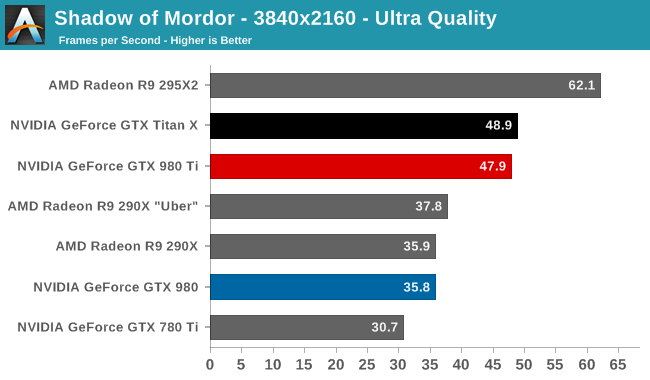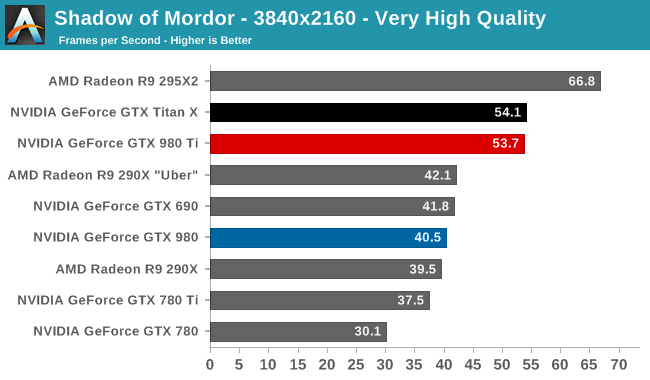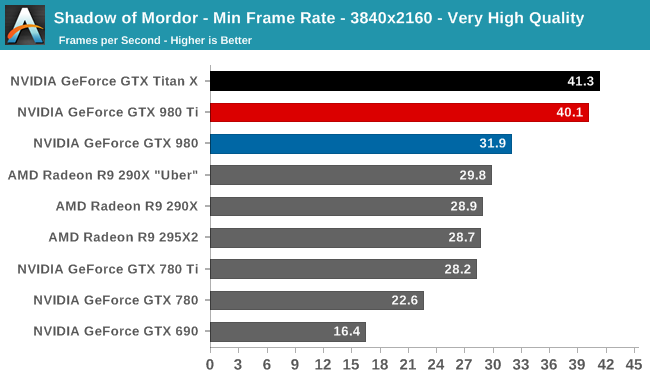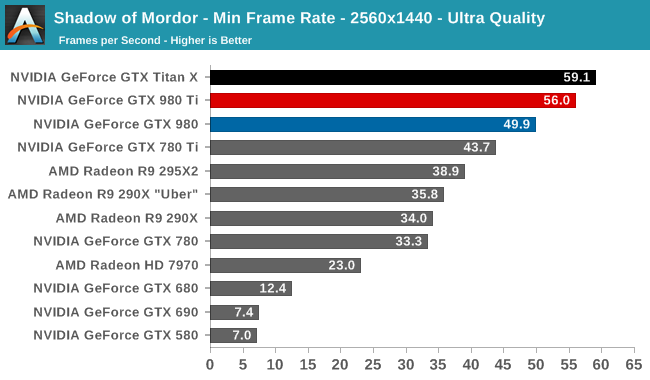The NVIDIA GeForce GTX 980 Ti Review
by Ryan Smith on May 31, 2015 6:00 PM ESTMiddle Earth: Shadow of Mordor
Our next benchmark is Monolith’s popular open-world action game, Middle Earth: Shadow of Mordor. One of our current-gen console multiplatform titles, Shadow of Mordor is plenty punishing on its own, and at Ultra settings it absolutely devours VRAM, showcasing the knock-on effect of current-gen consoles have on VRAM requirements.



Another game, another set of benchmarks where the GTX 980 Ti and GTX Titan X are more or less tied. In this case the latest GM200 card closes the tiny gap even more, bringing the difference between the two down to 1-2% in favor of the GTX Titan X. Meanwhile the GTX 980 Ti’s advantage over the GTX 980 is as strong as ever, beating the most powerful of the GM204 cards by 30% or more.
On an absolute basis, as with Crysis 3 GTX 980 Ti won’t be enough for 60fps at 4K, but at 47.9fps it’s closer to 60fps than 30fps, representing a significant improvement in 4K performance in only a generation. Turning down the game’s quality settings to Very High does improve performance a bit, but at 53.7fps it’s still not quite enough for 60fps. The biggest advantage of Very High quality is alleviating some of the high VRAM requirements, not that the GTX 980 Ti seems to mind even at 6GB. Otherwise dropping to 1440p will give us a significant bump in performance, pushing framerates over 80fps once again.



Looking at minimum framerates, we find the one and only place under which the GTX 980 Ti may be struggling to keep up with its Titan sibling. While it held very close to the GTX Titan X in average framerates, the minimum framerate finds a larger, distinct gap between the two, with the GTX 980 Ti trailing by 8%. That said, minimum framerates are inherently more unreliable than averages, and other than a momentary dip the GTX 980 Ti is doing quite well here, so while it’s a less-than-perfect showing, I don’t believe we’re seeing any kind of real impact from VRAM differences. Note that the 4GB cards don’t seem to be worse off despite being short a further 2GB of VRAM.










290 Comments
View All Comments
Klimax - Tuesday, June 2, 2015 - link
Just small bug in your article:Page "GRID Autosport" has one paragraph from previous page.
"Switching out to another strategy game, even given Attila’s significant GPU requirements at higher settings, GTX 980 Ti still doesn’t falter. It trails GTX Titan X by just 2% at all settings."
As for theoretical pixel test with anomalous 15% drop from Titan X, there is ready explanation:
Under specific conditions there won't be enough power to push those two Raster engines with cut down blocks. (also only three paths instead of four)
Ryan Smith - Wednesday, June 3, 2015 - link
Fixed. Thanks for pointing that out.bdiddytampa - Tuesday, June 2, 2015 - link
Really great and thorough review as usual :-) Thanks Ryan!Hrobertgar - Tuesday, June 2, 2015 - link
Today, Alienware is offering 15" laptops with an option for an R9-390x. Their spec sheet isn't updated, nor could I find updated specs for anything other than R9-370 on AMD's own website. Are you going to review some of these R9-300 series cards anytime soon?Hrobertgar - Tuesday, June 2, 2015 - link
When I went to checkout (didn't actually buy - just checking schedule) it indicated 6-8 day shipping with the R9-390X.3DJF - Tuesday, June 2, 2015 - link
Ummm....$599 for R9 295X2?......where exactly? every search i have done for that card over the last 4 months up to today shows a LOWEST price of $619.Ryan Smith - Wednesday, June 3, 2015 - link
It is currently $599 after rebate over at Newegg.Casecutter - Tuesday, June 2, 2015 - link
From most result the 980Ti offer 20% more @1440p than a 980 (GM204) and given the 980Ti cost like 18-19% more that the orginal MSRP of the 980 ($550) It's really not any big thing.Given GM200 a 38% larger die, and 38% more SU's over a GM204 and you get 20% increase? It worse when a full TitanX is considered, that has 50% more SU's and the TitanX get perhaps 4% more in FpS over the 980Ti. This points to the fact that Maxwell doesn't scale. Looking at power the 980Ti is needing approx. 28% more power, which is not the worst but is starting to indicate there a losses as Nvidia scaled it up.
chizow - Tuesday, June 2, 2015 - link
Well, I guess its a good thing 980Ti isn't just 20% faster than the 980 then lol.CiccioB - Thursday, June 4, 2015 - link
This is obviously a comment by a frustrated AMD fan.Maxwell scales perfectly as you didn't consider the frequency it runs.
GM200 is 50% more than a GM204 in all resources. But those GPU run at about 0.86% of GM204 frequency (1250 vs 1075). If you can do simple math, you'll see that for any 980 results, if you multiply it by 1.5 and then for 0.86 (or directly for 1.3, that means 30% more) you'll find almost exactly the numbers the 980Ti bench shows.
Now that the new 980 $500 price, do the same and... yes, it is $650 for 980Ti.
Oh, the die size... let's see... 398mm^2of GM204 * 1.5 = 597mm^2 which compares almost exactly with the calculated 601m^2 of GM200.
Pretty simply. It shows everything scales perfectly in nvidia house. Seen custom cards are coming, we'll see GM200 going to 50% more than GM204 at same frequency. Yet these cards will consume a bit more, as expected.
You cannot say the same for AMD architecture though, as with smaller chips GCN is somewhat on par or even better with respect to nvidia for perf/mm^2, but as soon as real crunching power is requested GCN becomes extremely inefficient under the point of both perf/Watt or perf/mm^2.
If you tried to plant a doubt about the quality of this GM200 or Maxwell architecture in general, sorry, you choose the wrong architecture/chip/method. You simply failed.